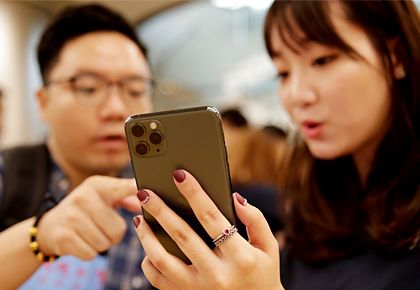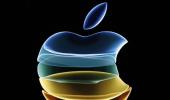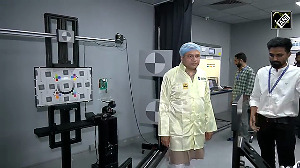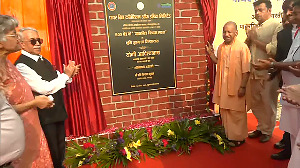Apple says the A13 Bionic was the most power-efficient chip it's ever made -- it needs 40 per cent less power than the previous chip in the Apple Bionic series to perform the same tasks as the previous phones, says Devangshu Datta.

Onstage at the Apple event on September 10, the company claimed that the new A13 Bionic chip, which runs its iPhone11 series, is the fastest Central Processing Unit (CPU) ever put into a smartphone.
It also claimed that the A13 has the fastest Graphics Processing Unit (GPU) in a smartphone.
Moreover, Apple said that the A13 Bionic was the most power-efficient chip it's ever made -- it needs 40 per cent less power than the previous chip in the Apple Bionic series to perform the same tasks.
There were additional claims that the A13 was well-designed for "machine learning (ML)" and running neural networks.
The A13 is the engine that powers the new IPhone 11 series.
In order to understand why this chip is considered a big advance on previous generations, we need to dive into the weird and wonderful world of electronics and microprocessor design.
The transistor was invented in 1948 at Bell Telephone Labs by a team of three physicists -- William Shockley, John Bardeen and Walter Brattain.
They shared the Nobel Prize.
A transistor is a small circuit with at least three connections, which uses semi-conductors (materials that allow passage of electrical current, but with higher resistance than metals).
Many transistors can be put together to create integrated circuits (ICs).
Microprocessors are the ICs that process instructions in a computer (or a microwave, or a smart TV).
They are commonly called "chips".
The accent is on small, as in physically small.
The smaller the better.
If more transistors can be pushed into the same physical space, processing becomes quicker and less power is needed to push current through the chip.
In the 1960s, Gordon Moore, who was a co-founder of Intel Corporation, discovered that the number of transistors per square centimetre in ICs was doubling every year.
This so-called Moore's Law held for many years -- it has now slowed to a doubling every two years or so.

The A13 has 8.5 billion transistors, which is a huge advance on the earlier A12 Bionic (which powers the iPhone 10) with 6.9 billion transistors.
The A13 is also a physically smaller chip -- every transistor is about seven nanometres.
There are 10 million nanometres to a centimetre.
Size, or the lack of, it isn't everything, however.
Chips are designed to carry out computer instructions, by opening and closing circuits as required.
Computers process instructions by carrying out mathematical operations on the binary system, which uses only the numbers 0 and 1.
A live circuit where current can pass is a "1", and a powered down circuit is "0".
Chip design involves optimising to efficiently process the type of problems that the computer most commonly handles.
Chip manufacture consists of three different tasks.
One is designing the hardware to make it as small and physically efficient as possible.
Another is working out the most efficient way to solve specific problems -- the logical instructions.
The third is fabrication of the chip at scale.
It can take three or four years for a new chip to evolve from concept to design to fabrication.

Modern computers -- and this includes smartphones -- use a CPU to carry out common instructions.
They also have a co-processor -- a GPU to handle the extremely intensive calculations required to handle graphics.
(GPUs can be used for other purposes as well.)
In a smartphone, where space is at a premium, CPU and GPU are bundled together onto the same chip.
The Bionic series, for example, bundles CPU and GPU together.
Low power usage is also a must, for obvious reasons in battery-powered devices.
Very few companies do both chip design and fabrication -- Intel would be the prime example of such a company.
There are specialised chip designers -- "fabless manufacturers", as they are called.
Some of these fabless companies, like Cambridge's ARM Holdings, just do chip design and license out the patents to cellphone and computer makers.
Other companies do chip fabrication on contract -- they churn out millions of chips in their factories at a combination of the lowest price and highest quality possible.
Apple has its own in-house chip design department.
This fits with Apple's philosophy of controlling and integrating the hardware and software in all its products.
In 2008, it bought a small outfit called PA Semiconductors for $278 million.
This evolved into its own chip design department. (Apple also buys chips from Intel for its Macs.)
The Bionic series is focussed on powering its iPhone range.
After making a few chips to run its own experiments, Apple contracts out manufacturing.
The Bionic chips are made in tens of millions by Taiwan Semiconductor Manufacturing Company (TSMC), which, as the name suggests, is based in Taiwan.

So what's special about the A13 Bionic?
Its predecessor, the A12 , was already among the fastest chips around.
The A13 is supposedly even faster.
It is also optimised to run AI algorithms with its "neural cores" that the company claims will make it the fastest in machine learning.
It can run 1 trillion operations per second.
The chip is power efficient with claims that it can provide up to four extra hours of battery life for the new iPhone 11 Pro and up to five hours for the iPhone 11 Pro Max.
It has a system that can selectively shut down power to parts of the chip when it's not using them.
Buzzwords like ML and AI sound impressive.
But what do they really mean?
Since the phone isn't out yet, the geek world is indulging in a lot of conjecture.
Taking the specifications on trust, it appears that the A13 would be very good at image processing.
That would make the iPhone11 a gamers' delight.
It would also make it easier to run face-recognition programs and do video editing and the like.
This ties in with Apple's other announcements.
Apple TV launches in November, while Apple Arcade, which is the new suite of proprietary games, launches next week.
Both are bundled into deals with the new iPhone11.

In addition, the high-end versions of the new phone boast a four-camera setup and Apple claims that it can edit feed acquired from all four cams simultaneously.
This would be heavily dependent on the capabilities of the new chip.
Creating a handheld device with the capacity to splice and edit like a TV studio could revolutionise vlogging.
Importantly, developers can use the capacity of the new device to create new apps, which can only run on this platform with its unique integration of high-powered hardware and software.
This could be the real game-changer.
All it could take to make the iPhone11 a roaring success could be one viral app that turns it into a must have.














 © 2025
© 2025